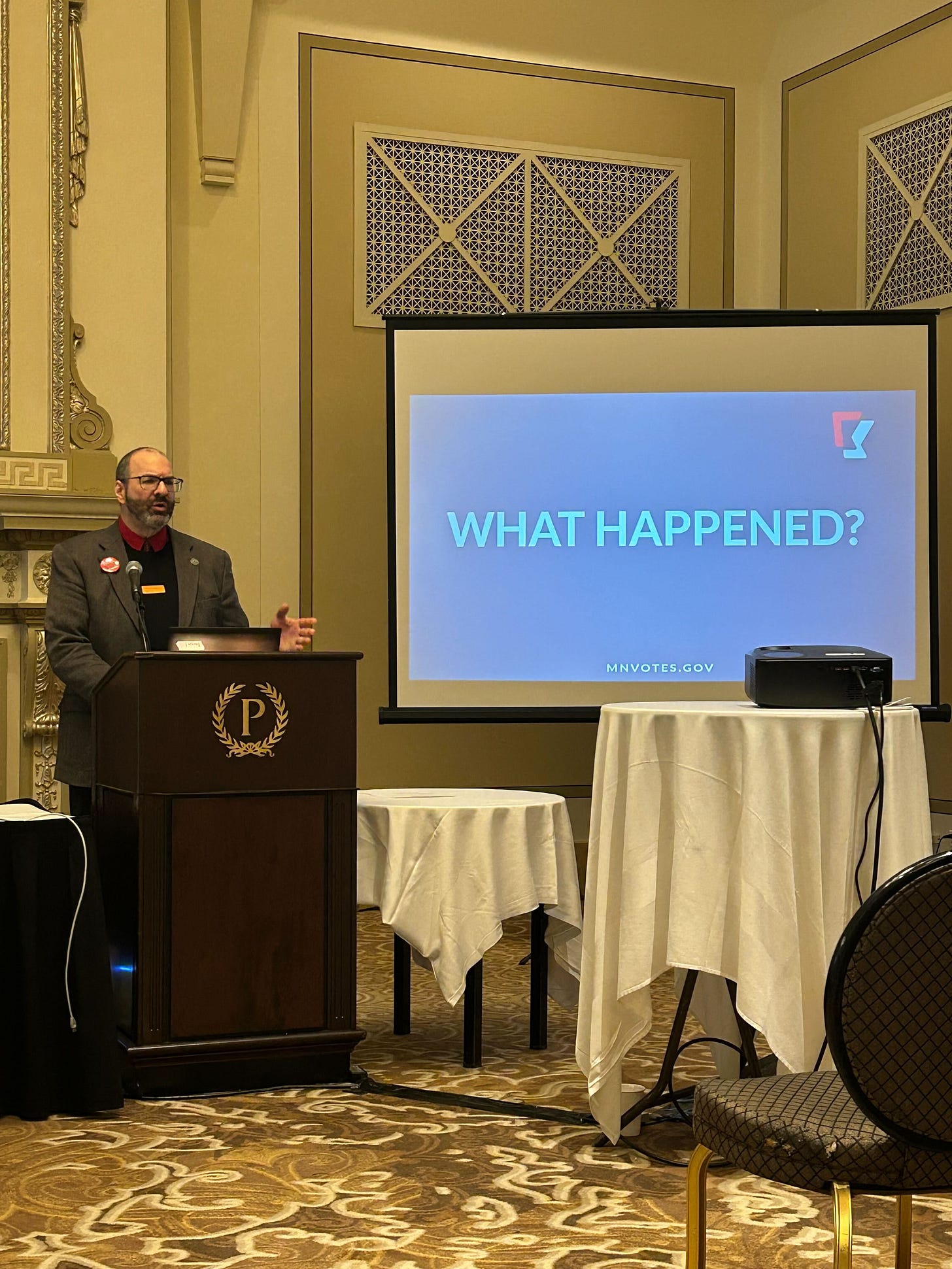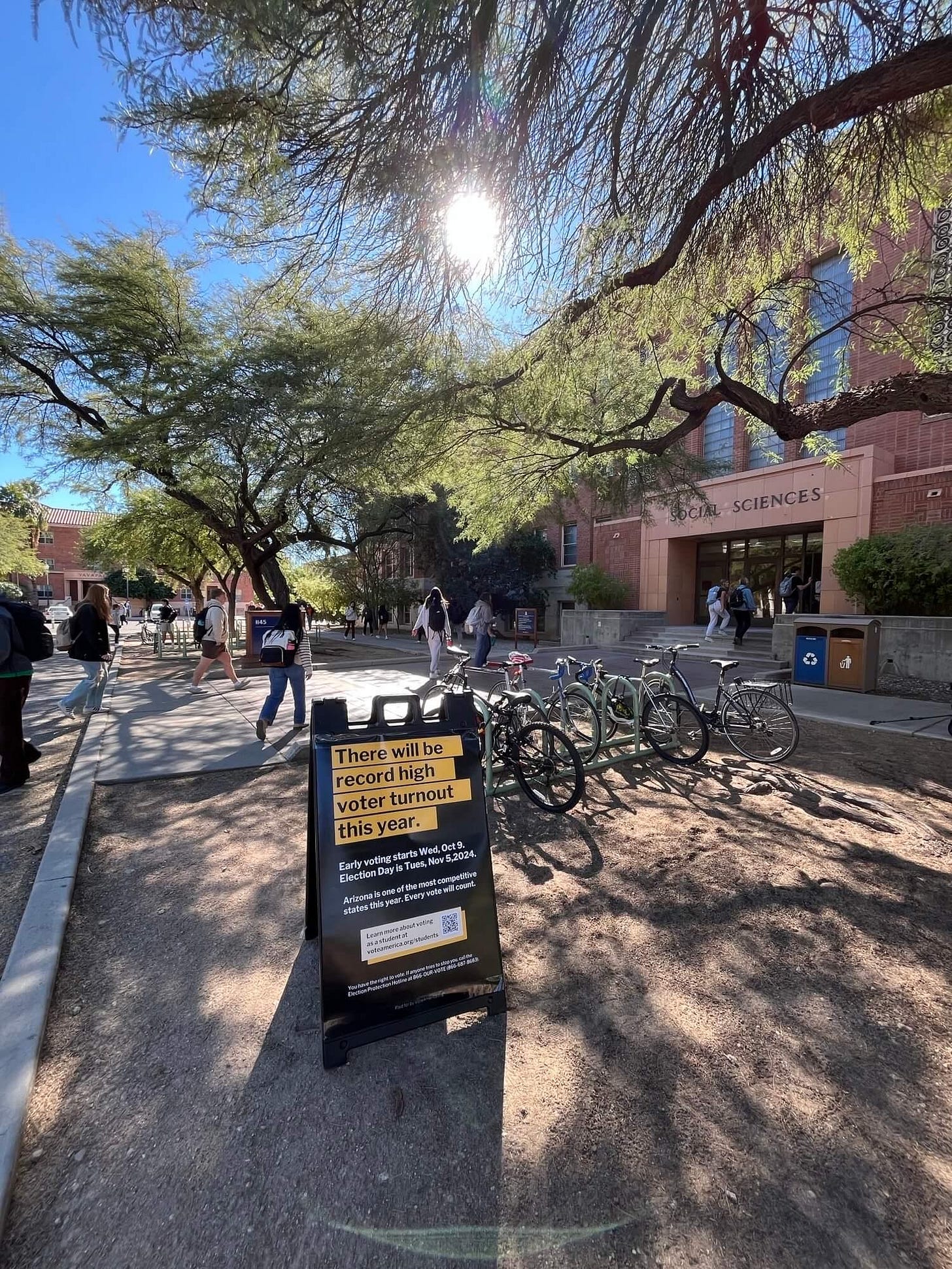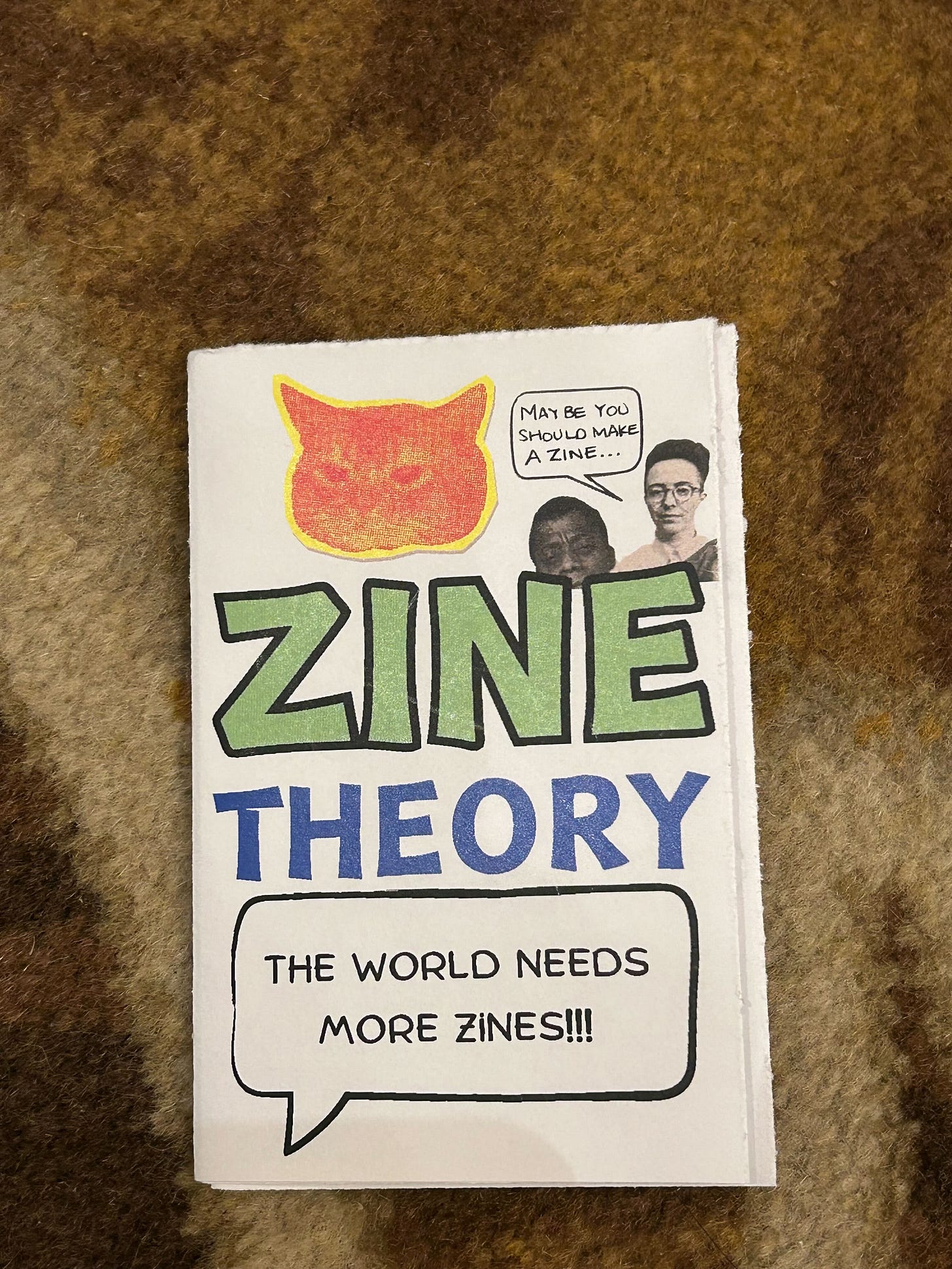What Happened and What We Learned at the 2025 State of the Student Vote Workshop
From “FOMO messaging” to micro-targeting and much, much more
On Thursday, April 3, academics and practitioners gathered in the Honoré Ballroom of the Palmer House Hilton in downtown Chicago to hear about recent nonpartisan efforts to research and execute strategies that encourage student voter registration and turnout. The annual Student Vote Research Network (SVRN) gathering included nine presentations and offered members of the movement for 100% student voter turnout a chance to network and exchange ideas in person in an informal setting.

Each presentation shared unique insights to the group about the important and groundbreaking work going on throughout the SVRN. Here are some of the lessons we learned that afternoon:
Student voters turn out more when they’re informed… and afraid of missing out.
VoteAmerica’s Brenna Cully presented on her organization’s get-out-the-vote efforts that use campus media to encourage student turnout. The campaign, which included 127 campuses in 7 states for the fall 2024 elections, reached 1.5 million students with messaging that appeared on bus stop posters, on the side of buses as well as inside them, on posters and sandwich boards around campus, and, in one case, a banner pulled behind a small airplane that flew over a football game.
Throughout the campaign VoteAmerica employed two types of messaging: necessary voter information—i.e., where and when students can vote and what they need to bring with them - and what Vote America calls “FOMO Messaging” (FOMO is internet slang for “fear of missing out”): a more neutral form of social pressure messaging, such as “your friends will know if you don’t vote,” that research has shown to be widely effective. VoteAmerica’s FOMO messaging focused instead on anticipated record voter turnout in 2024, emphasizing to students that voting is normal and implying that *not* voting is abnormal. Overall, they believe this use of campus media had a statistically significant impact on its targeted audience’s voter turnout rate, increasing it by 2 percentage points.
Cultural micro-targeting can normalize voter participation among certain populations.
Sudhanshu Kaushik, who founded the North American Association of Indian Students (NAAIS), presented on his organization’s efforts to partner with student clubs across 18 universities to integrate GOTV content into existing programming for Indian American students, such as Diwali and other cultural events. Kaushik also spoke to the value of focusing on subgroup cultural events that don’t simply target individuals among the 800,000 Indian American students in the US, but also speak to the many different regional cultures, languages, and customs found within the Indian American community.
Through their efforts in 2024, NAAIS registered 7,421 students with strategies focused on making registering to vote fun and entertaining, and making members of smaller cultural and ethnic groups from within the larger umbrella group of Indian Americans feel seen, by using in-group references from their subgroups.
Building relationships with local election officials is crucial to addressing barriers for young voters.
Project 26 Pennsylvania Voter Access Director Rachel Tait presented on her efforts leading a program to mobilize 18-24 year-olds in PA, laying out how systemic issues can arise due to the fact that young voters’ needs and concerns often aren’t considered by decision-makers involved in local election administration.
Tait’s organization mapped tactics to address each type of pre-election and Election Day barrier faced by students across the Keystone State, including educating voters in advance and organizing poll observers and hotlines. She also noted how when one campus moved to institute digital student ID cards, they contacted their local election office to ensure that those would be acceptable forms of voter ID.
Tait encouraged everyone to build relationships with their county election officials and to create campus-specific voter information for each institution.
Recruiting student poll workers may improve the voting experience and encourage turnout.
Campus Vote Project’s Shellby Branch shared exit poll results from a Fall 2024 effort to recruit poll workers in Arizona, Michigan, Pennsylvania, Virginia, and Wisconsin. To measure impact, Branch’s group conducted exit polls at campus polling places at the University of Wisconsin, the University of Mary Washington, and James Madison University. Overall, surveys were collected from about 300 voters, about 25% of whom said they knew at least one of the poll workers. The group also reported high overall levels of satisfaction among the voters interviewed. Moving forward, they hope to document the degree to which having student poll workers makes a difference for student voters.
When it comes to encouraging student voter turnout, favorable laws are just the beginning.
Michael Wall, the Youth Voter Outreach Specialist at the Office of the Minnesota Secretary of State, shared details about the implementation and impact of state legislation in 2023 that required any higher education institutions in the state of Minnesota that received state funding to complete a number of actions to facilitate voter turnout among its student population. Wall spoke favorably of the legislation and its impact on voter engagement, while acknowledging that without an enforcement apparatus it’s difficult to ensure all institutions are compliant with the new law—especially when some of its aspects require institution personnel to take on new or additional responsibilities. As Minnesota works toward 100% student voter turnout, Wall is optimistic working with institutions to maximize the legislation’s impact will move things in the right direction.
Nonpartisan voter engagement action planning reached all-time highs in 2024
Ryan Drysdale from the ALL IN Campus Democracy Challenge shared findings from nonpartisan student voter engagement action plans in 2024, detailing extraordinary progress seen over the past few years. In 2024, a record 632 campuses submitted action plans, with increases across all campus types and contexts. Within the plans themselves, campuses are making substantive improvements, with nearly half of all plans submitted detailing specific plans to work with local election officials, and 44% detailing leadership succession plans—a key component of developing institutional strategic capacity. Drysdale also noted the power of presidential commitments as part of any campus’s nonpartisan voter engagement efforts, as college presidents’ status and influence within local communities are a potentially powerful tool for buoying collective action.
Zines can be a means to civic empowerment.
Adriana Paez from the University of Missouri, Kansas City presented on her work over the past three years helping build youth civic engagement through the creation and distribution of zines: self-published, small-circulation publications that are often homemade and/or devoted to specialized or unconventional subjects.
In her presentation, Paez emphasized the importance of making civic engagement education fun and creative, which she achieved not only with the creative design of her zines, but also in the “sneaky” way she distributed them, leaving them in unconventional places such as rest rooms where students may happen upon them unexpectedly. Paez also believes that using zines helps young people use their voices, process what’s happening in the world, and speak to their peers directly.
In her experience, zines proved to be an entertaining and attention-grabbing way to inform students on important topics, including changes in Missouri state law that revoked students’ right to vote using their college ID as voter ID, as well as QR codes that directed students to voter registration sites and other relevant information.
Fully immersive voter experiences make casting a ballot less daunting and more fun.
University of Michigan Art & Design Associate Professor Hannah Smotrich presented on her “Creative Campus Voting Project,” in which she and UM colleague Stephanie Rowden worked with local election officials to open campus voting hubs that were decorated to feel as if voters were walking through different enlarged sections of their ballot.
To accompany the immersive design—which provided extra information explaining each aspect of the ballot to voters in a visually appealing way—Smotrich and Rowden trained student workers to staff the site in a user-friendly manner. Student workers were instructed to smile and use conversational language while guiding their classmates through the Creative Campus Voting Project space, in order to make all participants feel welcomed and comfortable while avoiding cognitive overload.
To study the impact of the project Smotrich and Rowden conducted 61 interviews with students about their motivations for voting and the emotions they experienced when doing so, revealing overwhelmingly positive feelings about how the campus voting hubs impacted the voting experience.
Smotrich said she believes similar projects are replicable at other institutions, encouraging others to focus on three principles:
Deliver information students need in a way that they can receive it.
Create opportunities to foster social fabric and a sense of belonging.
Collaborate across disciplines for complementary expertise.
Faculty-student partnerships can foster civic engagement with impact beyond the next election.
In 2024, Columbia College Chicago professor Sharon Bloyd-Peshkin changed her voter engagement messaging strategy to better suit her students’ ongoing experiences. At this month’s workshop Bloyd-Peshkin shared how that strategy manifested with her team of student “voter registration geniuses.”
At classroom presentations throughout campus, geniuses begin by asking students “what do you care about?” and then connect elections to those issues and the experiences of students’ everyday lives. They then introduce students to voter information and voter registration resources, and incentivize them to act with the chance to win prizes.
In the fall of 2024, Bloyd-Peshkin and her team assigned the theme “civic joy” to their efforts, collaborating on a number of fun activities for the CCC student body, including making buttons and crafting zines, all with the end goal of educating and mobilizing students by helping them become confident voters.
Following the election, Bloyd-Peshkin and the voter registration geniuses were able to leverage the relationships they had built with the broader student body to continue engaging with students who had strong feelings about the 2024 election, helping them understand the results and its likely consequences, as well as how to continue on their civic engagement journey going forward.






